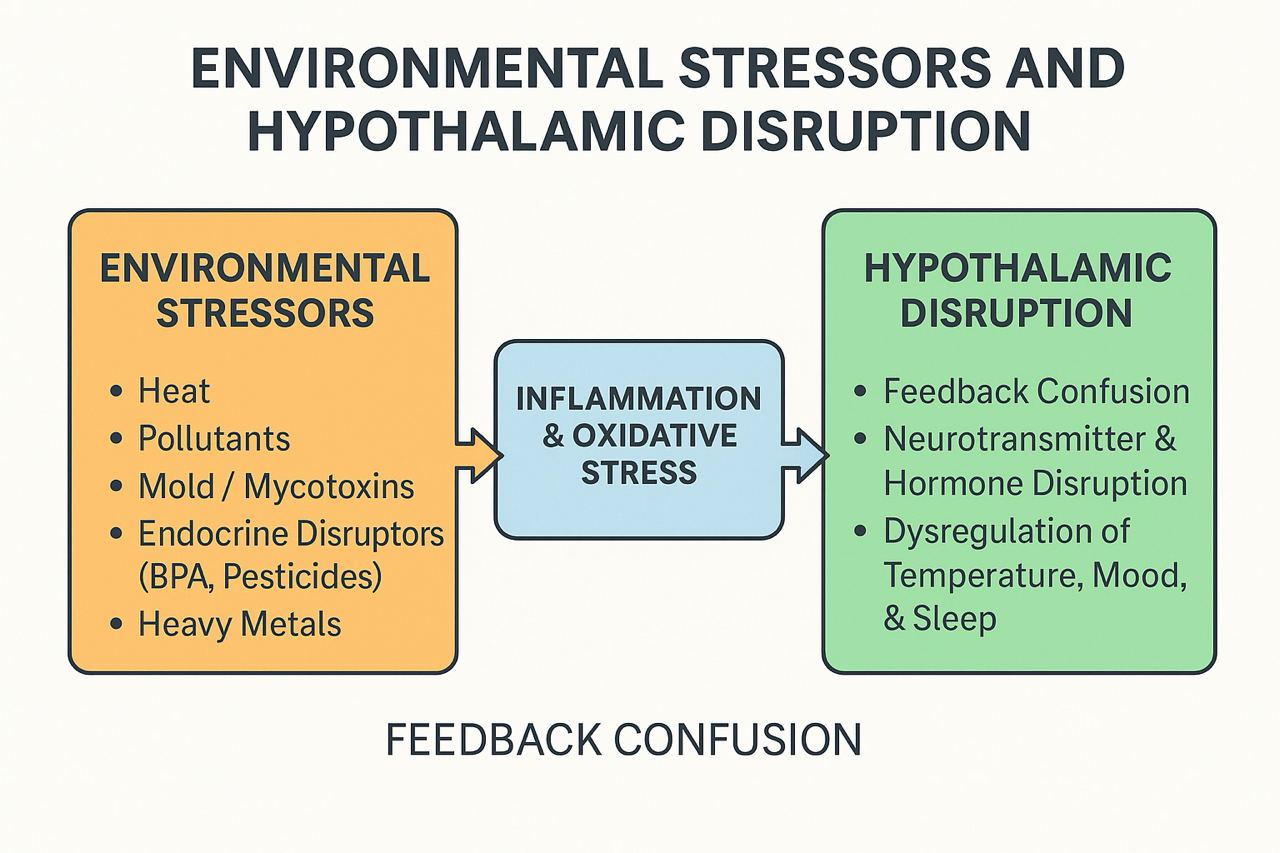The Surprising Reason You Feel Hot All the Time–and It’s Not Menopause.

Doctors Miss This One Thing When Treating Hot Flashes — And It’s Everywhere Around You
Hot flashes are often viewed as a symptom exclusive to menopause — a fleeting, uncomfortable surge of heat linked to hormonal changes in women. Yet, more people today, including men, are experiencing chronic heat surges, night sweats, and thermoregulatory instability without any direct hormonal cause. Emerging evidence suggests that environmental stressors and toxic exposures may play a major role by disrupting the brain’s temperature control center — the hypothalamus.
The Hypothalamus: The Body’s Thermostat
The hypothalamus regulates temperature, hunger, thirst, sleep, and hormonal balance. It constantly receives sensory feedback about internal conditions — like body heat or blood sugar — and sends signals to maintain equilibrium.
When the hypothalamus detects overheating, it activates cooling mechanisms such as sweating and vasodilation (widening of blood vessels). When cold, it triggers shivering and vasoconstriction to conserve warmth. This precise balancing act, called homeostasis, depends on healthy neural and hormonal communication.
However, chronic exposure to pollutants, chemicals, or stress hormones can scramble this communication network, creating what scientists call feedback confusion — a state where the brain misreads normal signals and triggers unnecessary or exaggerated responses.
⚙️ What Is Feedback Confusion?
Under healthy conditions, the hypothalamus uses feedback loops to monitor and adjust body functions. For example:
-
When body temperature rises, sensors in the skin and brain send a message to the hypothalamus.
-
The hypothalamus then signals sweat glands to cool the body.
-
Once the temperature returns to normal, the feedback loop shuts off.
In feedback confusion, this off-switch malfunctions. The hypothalamus receives mixed or distorted information — either from damaged neurons, inflammation, or chemical interference. It can then activate the wrong response, like cooling the body even when it’s already at a normal temperature.
Over time, this misfiring becomes chronic. The body begins to experience:
-
Erratic heat surges (hot flashes)
-
Sweating or chills without environmental triggers
-
Fatigue or mood swings tied to thermoregulatory stress

Environmental Factors Behind Feedback Confusion
Environmental toxins amplify this confusion by directly affecting the brain’s signaling chemistry:
-
Endocrine Disruptors (BPA, Phthalates, Pesticides)
Mimic hormones like estrogen or testosterone, hijacking feedback receptors in the hypothalamus.
→ The brain reads false “temperature” or “stress” signals and overcorrects, causing hot flashes. -
Mold & Mycotoxins
Release inflammatory compounds that interfere with neural communication in the hypothalamic–pituitary–adrenal (HPA) axis).
→ The brain stays in alert mode, keeping temperature-regulating systems hyperactive. -
Pollutants & Heavy Metals
Cross the blood-brain barrier, triggering inflammation and oxidative stress, damaging neurons that normally stabilize homeostasis.
→ The result is long-term feedback confusion that mimics hormonal imbalance symptoms. -
Chronic Heat or Stress Exposure
Overstimulates the hypothalamus until its thresholds shift — it starts reacting to mild stimuli as if they were threats.
→ Each small fluctuation in internal temperature can now set off a wave of heat.
The Chain Reaction
Environmental stressors → Inflammation & oxidative stress → Hypothalamic feedback confusion →
Misfiring of cooling mechanisms (sweating, vasodilation) → Hot flashes and thermoregulatory instability
This is exactly what your diagram illustrates: the process that transforms constant environmental pressure into physiological chaos.
️ In Simple Terms
Hot flashes in this context aren’t just hormonal — they’re a neurological misfire caused by environmental overload. The hypothalamus, designed to protect balance, becomes the victim of its own confusion. It reads mixed signals, overcompensates, and keeps the body swinging between heat and cold.




